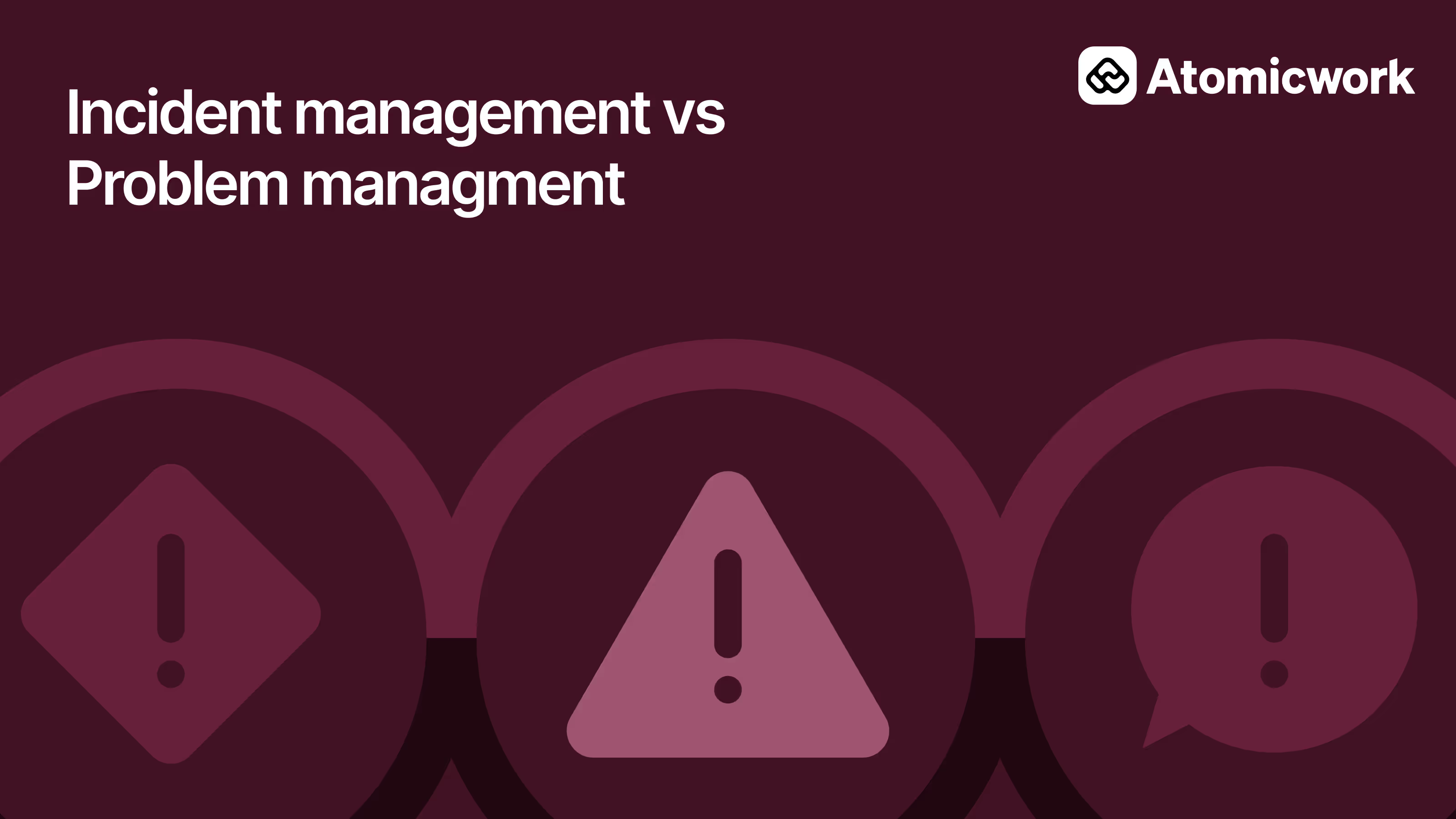The Modern Guide to IT Incident Management
The IT landscape as we know is continuously evolving and so are the processes involved in IT service management. One such process is incident management in IT environments, which is positively impacted by artificial intelligence.
In fact, according to our recent State of AI in IT 2024 report, 28% of US IT leaders pointed to IT infrastructure management as one of their top 4 AI in IT use cases.
In this guide, we examine the role of AI in transforming incident management processes and discuss how IT incident management has adapted to align with the ITIL V4 framework that emphasizes better flexibility, collaboration, and continuous improvement.
What is incident management in IT?
Incident management in IT is the process of identifying, analyzing, and resolving incidents to restore normal service operations as quickly as possible and minimize the impact on business operations.
With AI, incident management is becoming more automated than ever. Using AI, enterprises can improve IT self-service, provide 24/7 incident support, drive faster resolutions, and enhance incident handling by learning from similar incident histories.
Before we dive into the processes involved in ITIL incident management, let’s see what constitutes an ‘incident’.
What is an incident?
An incident is simply any event that disrupts or could potentially disrupt a service. The primary goal of incident management is to ensure that IT services are swiftly back to normal operation mode, ensuring minimal downtime while maintaining service quality.
Examples of incidents
In modern workplaces, IT incidents can vary widely in nature and impact. These incidents typically involve disruptions or degradations in IT services, affecting the efficiency and productivity of the organization.
Here are some common examples of IT incidents in contemporary work environments:
Without an effective incident management process in place, these ‘incidents’ could significantly harm productivity, customer satisfaction, and the bottom line.
8 steps in the IT incident management process
1. Incident identification
Incident identification focuses on detecting potential issues before they escalate into major problems. This proactive approach involves using monitoring tools that continuously track system performance, availability, and security. These tools can alert IT teams when predefined thresholds are breached, indicating a potential incident.
Additionally, incidents can be reactively logged when users report problems with IT services through various channels such as email, phone, or a self-service portal. Encouraging users to report issues promptly helps identify incidents early and minimizes their impact on business operations.
Pro tip: Using AI, IT teams can automate the identification of incidents, eliminating the need for manual intervention to initiate the incident management process.

2. Incident logging
Once an incident is identified, it is crucial to log all relevant details in a centralized system, such as an IT service management (ITSM) tool. This step involves recording a comprehensive description of the issue, including the affected services, users, and the time the incident occurred.
The severity level of the incident is also determined based on predefined criteria, which take into account factors such as the number of users impacted, the criticality of the affected services, and the potential financial or reputational damage. Accurate and detailed incident logging is essential for effective prioritization, diagnosis, and reporting.
Pro tip: An AI-powered assistant integrated within employee collaboration tools like Slack enables IT teams to gain more insight into incidents by allowing employees to provide additional context through attaching images, documents, and error logs relevant to the incident.
3. Incident categorization
Incident categorization is the process of assigning appropriate categories to incidents based on their nature and characteristics. This helps route the incident to the team or individual best suited to handle the resolution.
Categories can be based on factors such as the type of issue (e.g., hardware, software, network), the impacted service or application (e.g., email, CRM, ERP), and the required expertise (e.g., database administration, cybersecurity).
Accurate categorization streamlines the resolution process by ensuring that incidents are assigned to the right people with the necessary skills and knowledge. It also enables better reporting and trend analysis, helping identify recurring issues and areas for improvement.
Pro tip: AI intelligently recognizes and categorizes incidents, streamlining the process of routing them to the appropriate teams or individuals for resolution.

4. Incident prioritization
Incident prioritization determines the order in which incidents should be addressed based on their urgency and impact on the business.
Prioritization takes into account the severity level assigned during the logging step, as well as other factors such as the number of users affected, the potential financial impact, and any applicable service level agreements (SLAs).
Incidents with a higher priority, such as those impacting critical systems or a large number of users, are addressed first to minimize downtime and ensure business continuity.
Effective prioritization ensures that IT teams focus their efforts on the most pressing issues, optimizing resource allocation and reducing the overall impact of incidents on the organization.
Pro tip: AI can help in the prioritization of incidents based on predefined criteria, ensuring that the most critical issues are addressed promptly.
5. Incident diagnosis
Incident diagnosis investigates and identifies the root cause of an incident. This often begins with initial triage, where the assigned IT team member gathers more information about the issue from the affected users and systems. They may use various diagnostic tools and techniques, such as log analysis, network monitoring, and system health checks, to narrow down the potential causes.
In complex cases, the incident may be escalated to higher levels of support or specialized teams for further investigation. Incident diagnosis aims to pinpoint the underlying problem and collect the necessary information to develop an effective resolution plan.
Pro tip: Leveraging AI in incident management helps to easily identify patterns in incidents and recurring issues, helping you refine your incident playbooks. You can also conduct an in-depth analysis of incidents based on severity, affected areas, custom attributes, and other relevant factors.

6. Incident resolution & recovery
Once the root cause of an incident has been identified, the focus shifts to implementing a resolution and restoring normal service operations. Sometimes, a temporary workaround may be necessary to restore critical services while a permanent fix is developed quickly.
The resolution may involve activities such as patching software, replacing hardware components, or reconfiguring systems. After the fix is implemented, thorough testing is conducted to ensure that the issue has been fully resolved and that there are no unintended consequences.
Following successful resolution, the affected systems and services are recovered, and normal operations resume. The resolution steps are documented in the incident record for future reference and knowledge sharing.
Pro tip: You can set up AI workflows that can be automatically triggered when an incident is created, updated, or its priority changes. This empowers your team to initiate incident playbooks without manual intervention or prioritization, including tasks such as assigning agents and executing actions within Azure AD, Okta, and BambooHR.

7. Incident communication
Effective communication is essential throughout the incident management process to keep stakeholders informed and maintain transparency. This involves providing regular updates at key milestones, such as when the incident is first identified, acknowledged, diagnosed, resolved, and closed.
Depending on the organization's preferences and the severity of the incident, communication channels may include email, messaging platforms, or a dedicated status page. Clear, concise, and timely communication helps manage expectations, reduce frustration, and foster trust between IT and the rest of the business.
It also ensures that everyone has the necessary information to make informed decisions and adjust their activities as needed during the incident. Post-incident, a summary report may be shared with relevant stakeholders to provide an overview of the incident, its impact, and the steps taken to resolve it.
Pro tip: Centralizing all your incident management in a single platform allows IT teams to send regular updates and coordinate all actions from the primary incident efficiently.

8. Incident closure
Incident closure is the final step in the incident management process, where the IT team verifies with the affected users that the issue has been fully resolved and that they are satisfied with the outcome.
This step involves updating the incident record with the resolution details, including the steps taken, the time and resources involved, and any relevant notes or observations.
The closure process also includes conducting a post-incident review to identify lessons learned or areas for improvement in the incident management process. Once all the necessary information has been captured and the users have confirmed their satisfaction, the incident is formally closed in the ITSM system.
Pro tip: An AI-powered incident management platform allows for efficient documentation of resolution details, lessons learned, and areas for improvement, facilitating a comprehensive post-incident review process.

Benefits of IT incident management?
IT incident management is important for several reasons including:
Incident management best practices
Implementing the below best practices can enhance the effectiveness of your incident management process:
Evolution of incident management as per ITIL V4
The ITIL V4 framework has introduced several changes to the incident management process, emphasizing flexibility, collaboration, and continuous improvement. Key updates include:
Enhance IT Incident Management with Atomicwork
Atomicwork recognizes the crucial role of an efficient IT incident management system in ensuring business continuity and customer satisfaction.
Our incident management tools empower organizations to seamlessly identify, respond, and resolve incidents quickly and effectively, streamlining processes, enhancing collaboration, and reducing the impact of incidents on business operations.
By leveraging Atomicwork's AI-driven automation and comprehensive incident management capabilities, organizations can set a new standard for IT operations, proactively addressing issues, and fostering a culture of continuous improvement and service excellence.
Want to manage IT incidents in your organization effectively?
Contact us, and we will be happy to assist you.
Frequently asked questions
Incident management in IT refers to the systematic approach to identifying, managing, and resolving IT incidents to restore normal service operations as quickly as possible. The objective of incident management is to minimize the impact on business operations, ensuring the highest possible level of service quality and availability.
ITIL defines an IT incident as 'an unplanned interruption to an IT service or reduction in the quality of an IT service'. Network outages, application crashes, and security breaches are some common examples of IT incidents.
The key steps in IT incident management include incident identification, logging, categorization, prioritization, diagnosis, resolution, and incident closure.
Yes, Atomicwork has powerful AI incident management capabilities that can automate your IT incident management workflow. Sign up to see Atomicwork in action for effective incident management.
More resources on modern ITSM






































